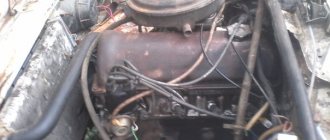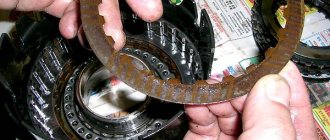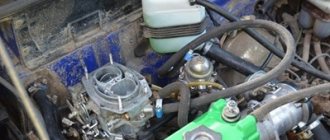If a car with an automatic transmission stalls, it means the engine stops turning the gearbox shaft. The oil pump, which creates pressure in the unit, is turned off. The box automatically switches to neutral mode. Causes:
- low quality fuel is filled;
- the mass air flow regulator has failed;
- breakdown of the crankshaft position sensor;
- The vacuum brake booster does not work;
- The throttle valve is clogged.
Look at the fuel level sensor in the tank, in case you simply forgot to refuel in the bustle.
When reverse gear is activated
Check the oil level - it may be too high. Inspect the gearbox switch set for reverse speed. It may fail.
I started moving in reverse and the car stalled.
Due to increased pressure, the torque converter may become blocked. The reason is increased oil supply. Start downhill in the neutral position, and then switch to reverse. You will feel whether the torque converter is blocked or not.
Automatic transmission stalls when put into drive
First change the oil in the box. Sometimes the dirt present is the main reason. Or there is a problem with the wear of the solenoids. This requires automatic transmission repair. The second reason is an electronic malfunction that requires diagnostics. Elimination is carried out based on the information received.
Cold car turns off when automatic transmission is turned on
Oil viscosity can only have an effect in very severe frosts. Modern cars take this factor into account. The reason may lie in the speed sensor reading incorrect readings. When the temperature rises, contact is restored and the element begins to perform work correctly.
If no problems are found in the electrical part, look at the mechanics. The box may need to be disassembled.
Injection engines
If a car with an injection engine stalls while driving, then there may be several problems of this kind:
- The oxygen enrichment system for the fuel mixture is faulty.
- Broken oxygen sensor.
- The intake manifold is malfunctioning.
- Fuel injectors are partially or completely dirty.
- The cooling system of the unit is broken.
If the owner himself is not sure of the cause of the breakdown, the same diagnostics are needed, after which repairs are already carried out.
You can describe some of the reasons in more detail, but do not forget that there can be a lot of them, and they are all different - it depends on the make of the car, the country of origin, the type of engine, etc.
The engine stalled while driving in a car with automatic transmission
If a car with an automatic starts and then turns off while driving, possible reasons:
- clogged spark plugs;
- interruptions in fuel supply;
- power supply failure;
- low or high oil level in the automatic transmission.
When turning on the speed
Often observed when driving slowly. During switching, the revs drop and the engine simply does not have time to catch them. The cause of constant failures may lie in failed solenoids.
Main reasons
- When changing gear, as well as at neutral speed.
- While pressing the gas.
- When the engine speed is reduced.
It is worth noting that the causes of problems for injection and carburetor engines are usually different. Another important factor is at what time the engine stalls: cold or hot.
The reasons may be the following:
- Poor quality gasoline. Engine malfunction may occur due to refueling with low-quality fuel. Any knowledgeable driver will ponder when and where the last gas station was filled. There are cases when, after refueling at another station or with a different brand of fuel, the car begins to stall while driving.
- Faulty spark plugs. If, while driving, along with a sudden stop of the engine, the car makes sudden movements in the form of jerks and starts poorly, then the reason is in the spark plugs.
- Fuel filter. Another cause of malfunction is a dirty fuel filter. Over time, as the fuel mixture passes through, the filter becomes clogged with waste. If there is a fault in it, it should be replaced.
- Why the car stalls while driving is due to a faulty fuel pump. With this malfunction, fuel cannot flow normally into the aggregate system; in this case, you simply need to replace the pump.
- The battery must be kept clean, the terminals must be cleaned on time, since without proper care they either oxidize or become clogged.
- The generator is a very serious and important part of the car. If it malfunctions, all energy consumption falls on the battery, which, without the support of a generator, can very quickly discharge, and the car will not just stall, but will stand somewhere in the middle of the road until it receives a charge.
- Air filter. When it becomes contaminated, a failure occurs in the timely enrichment of the fuel mixture. Very often, car owners forget to change the filter in a timely manner, which leads to malfunctions and breakdowns.
- Optional equipment. With a large number of installed additional parts that provide comfort to the owner, a huge amount of energy is consumed. The car begins to stall because it does not receive enough charge to operate normally.
6) Tow the vehicle correctly
If your car breaks down, then forget about a regular tow if it is equipped with an automatic transmission. Unless, of course, you care about the condition of the box. In this case, you have two options. First: call a tow truck. Second: tow the car so that the drive wheels are raised.
True, the latter option is undesirable, because, for example, if your car is front-wheel drive, you will have to raise the front wheels. In this case, the entire weight of the car will shift to the rear wheels. As a result, when towing the car to a service station, the rear suspension will become overloaded, which can lead to damage.
Additionally
- Brake malfunction. In this case, the design of the vacuum booster is usually faulty. The problem comes to light when braking hard - resulting in a stalled engine (i.e. it slowly stalls on its own). Usually the entire amplifier is replaced or its adjustment is made.
- Exhaust system. The exhaust system may be contaminated, and after such contamination the car simply cannot “spit out” all the accumulated gas and begins to “choke.” It is necessary to clean the muffler; if the problem is not only contamination, but also a breakdown of the catalyst, the exhaust system must be completely replaced.
Is it due to poor fuel quality? Often the problem is precisely the fuel of low quality, or that does not correspond to the brand of car the driver is driving.
Gas stations need to be carefully monitored.
Fuel tends to pollute and contribute to the rapid wear of many vital parts for a car.
When using low-quality mixtures, the following occurs:
- Rapid contamination of the fuel filter.
- Malfunctions appear in the operation of the injection nozzles.
- Throttle valves become dirty quickly.
- The fuel pump is not working properly.
The most important indicator of a malfunction is a gradual decrease in engine power, as a result of which the car will stall even when the gas pedal is sharply pressed. Many problems can be identified yourself without spending extra money to pay for the services of a service center, but if the problem is not eliminated during an external inspection and subsequent repair of fuel systems, you will have to conduct computer diagnostics to more fully and deeply identify problems.
If your car has an automatic transmission and the car periodically stalls while driving, then the problem is usually in the power supply.
When the transmission changes gear, the computer receives a notification that some part is faulty and decides to immediately turn off the engine. Problems with this type of car must be resolved as quickly as possible; repairs must be carried out only by specialists. Personal interference will lead to an even bigger problem.
3) Change the automatic transmission oil on time
When was the last time you changed the engine oil? What about an automatic transmission? While almost every car enthusiast can easily answer the question about the engine, the question about the gearbox will confuse many drivers. It is surprising that there are a huge number of people in the world who do not know that the oil in an automatic transmission needs to be changed.
And this despite the fact that, as a rule, the automaker indicates this in the car manual or in routine maintenance in the service book. So, if you don’t want to kill the “automatic” in your car, quickly run to the auto store, buy a good “transmission” for the automatic transmission (don’t forget to look at what fluids the automaker recommends filling in) and go to a service center to change the oil in the box. How often to change? Well, of course, as often as possible. If you have money, change it every 30,000-50,000 km. It's a pity for the money, there is no money - then change it every 60,000-75,000 km.
What to do if the car manufacturer indicated in the manual that the oil in the box is filled for its entire service life? You can, of course, listen to the car manufacturer and dealer, who will definitely confirm this to you, praising the indestructible box in your car. Many at this moment even begin to think that their car is ideal and perfection.
What should you do to avoid killing the machine gun in your car?
Driving a car with an automatic transmission is easier, unlike driving a car with a manual transmission, where everything is much more complicated. Fortunately, most modern cars are equipped with an automatic transmission, and every year more and more people are purchasing cars with automatic transmission. But did you know that you need to use an automatic transmission, following certain rules, so as not to kill the box?
Yes, yes, it is much easier to kill her than the “mechanic”. If this happens, you will be shocked at the cost of repairing it. This, of course, is the main disadvantage of the “automatic”. We have already written more than once about what to do to increase the service life of an automatic transmission in a car. It's time to update our list. So, let's go. Here are 8 things you should follow to avoid breaking the automatic transmission in your car.
Spark plug
According to statistics, the reason for a large number of cases of stalled engines is the spark plugs: they simply do not produce a spark. The spark plugs may be dirty, have deposits on them, or there may be a malfunction when applying voltage directly to the spark plug.
In any case, if the breakdown is caused by spark plugs, the car will jerk while driving. For example, if there is dirt on the spark plug contacts, then the problem is the low quality of the fuel mixture or malfunctioning oil supply systems, or oil splashes are found on the spark plugs, which indicates that a serious breakdown has occurred in the component cylinders of the engine. For an accurate determination, a complete examination of the engine at a car service is necessary.
If you delay repairs, you can get a lot of problems, since you will have to replace the entire set of pistons.
If a red-brown coating is found on the spark plugs, then the problem is the constant use of low-quality gasoline. It is worth replacing the spark plugs with new ones, changing the gas station with higher quality gasoline. But if this does not help, then you need to look for a wiring fault.
In the case of power supply, the following malfunctions occur:
- When installing a new battery, the terminals are poorly secured.
- Breakdown of high-voltage wiring.
- Faulty generator.
In case of malfunction, high-voltage wires are completely replaced. To ensure good contact between the battery and the terminals, you need to clean them with sandpaper. If the malfunction is in the generator, then it may occur in the event of a broken timing belt, as well as a malfunction within the unit itself. Generator breakdowns are easier to detect, since there is a special icon on the dashboard that lights up in case of any deviations.
Recommendations
So, the car stalled while driving, what to do next:
- Using the inertia of movement, push the car off the roadway, no matter whether it is a city road or a highway.
- Turn on the alarm.
- It is mandatory to install an emergency sign at the back of the car: there are plenty of fans of high-speed driving everywhere, there is no need to create an emergency situation.
- Put the car on the handbrake.
Option 2 for further developments:
- Do the repairs yourself.
- Find a way to transport the car to the service.
In order to avoid such unpleasant and unexpected moments when the car stalls while driving, you need to follow simple rules:
- Carry out vehicle diagnostics at a service center as often as possible.
- Carry out preventive maintenance and inspection of the machine yourself.
- Monitor the condition of parts and replace them in a timely manner so that the machine does not break down in unexpected places.
You should always have a tool with you to repair minor damage, as well as a can of gasoline to avoid stopping due to its absence.
Video “Features of operating an automatic transmission”
Everything about operating a car with an automatic transmission is on video (author: Vladimir Grechaninov).
In general, what I expected from day to day arrived - it stalled automatically











